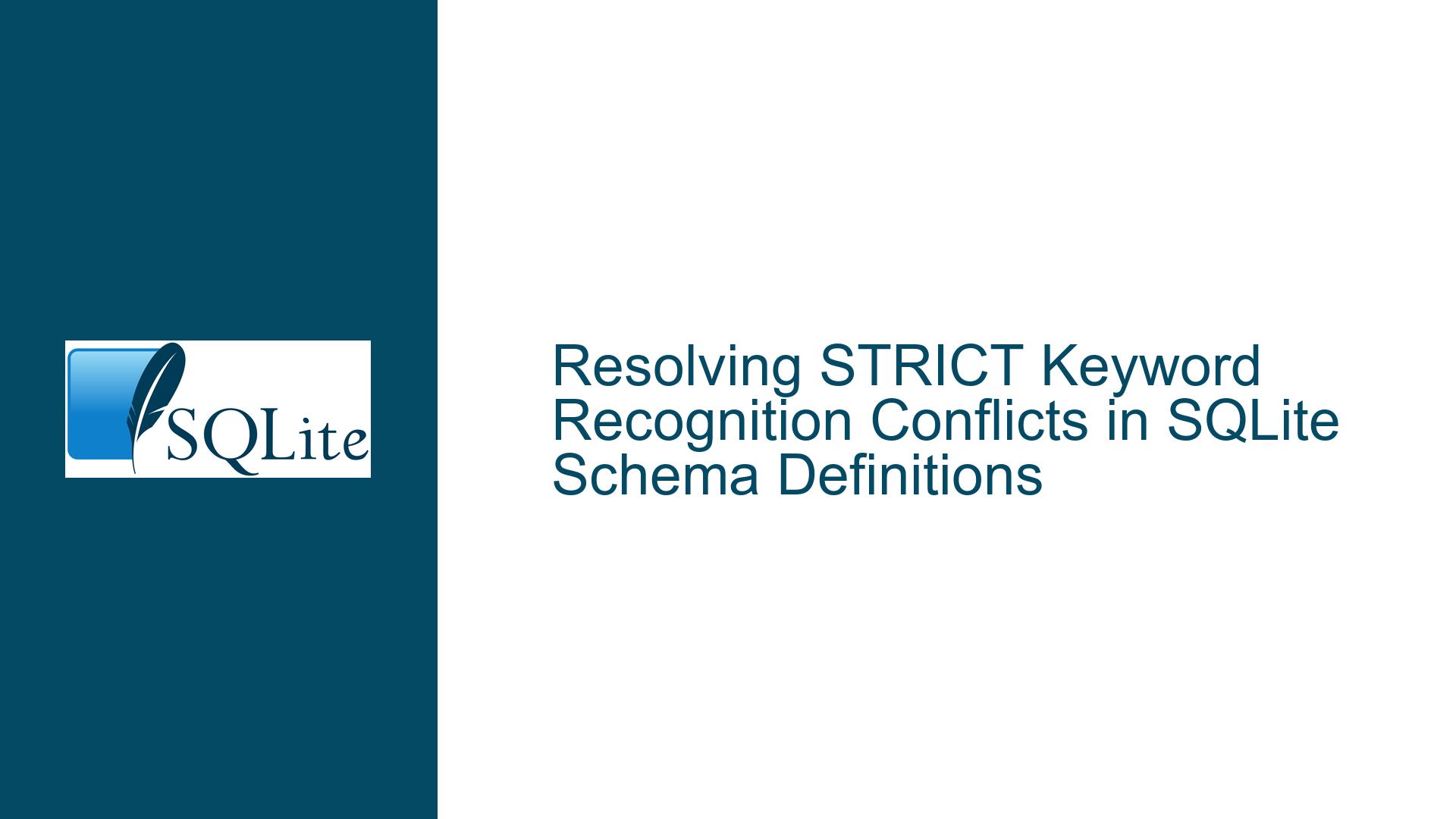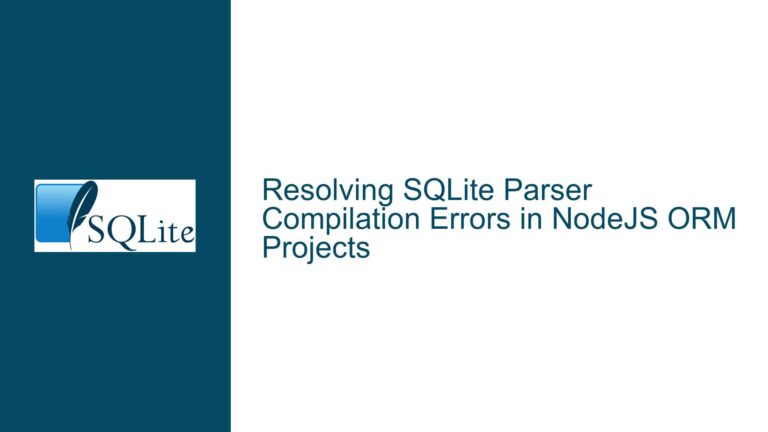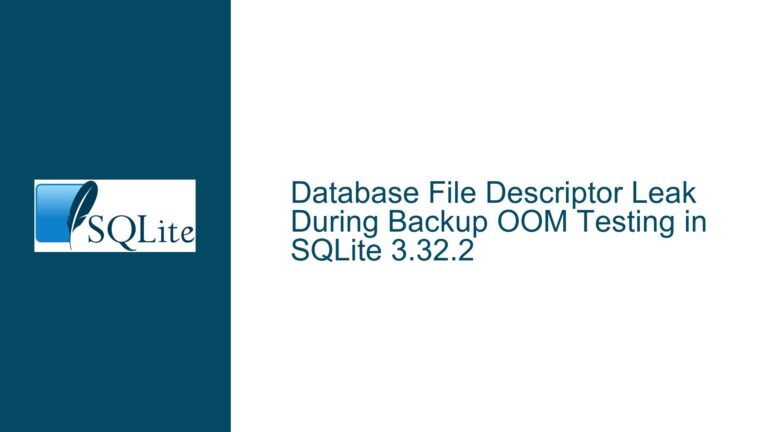Resolving STRICT Keyword Recognition Conflicts in SQLite Schema Definitions
Lexical Ambiguity of STRICT in SQLite’s CREATE TABLE Syntax
The STRICT keyword in SQLite introduces a unique challenge for developers working with table schema definitions. While it is recognized by the parser in specific contexts, it is not treated as a reserved keyword by the lexical analyzer. This discrepancy leads to inconsistent behavior when interacting with SQLite’s APIs or third-party tools that rely on keyword detection. Developers may encounter unexpected errors or misclassifications when using STRICT in table definitions, especially when integrating with ORM libraries, migration tools, or syntax highlighters. The root of this issue lies in SQLite’s layered architecture, where the lexical analyzer (lexer) and parser operate independently, with differing interpretations of certain tokens. This guide dissects the problem, explores its origins, and provides actionable solutions for schema design, query validation, and tool integration.
Divergent Behavior Between SQLite’s Lexer and Parser
SQLite processes SQL statements in two primary stages: lexical analysis and parsing. The lexical analyzer scans the input text, breaks it into tokens (identifiers, literals, keywords), and categorizes them. The parser then interprets these tokens to construct an abstract syntax tree (AST) that represents the query’s structure. The conflict with STRICT arises because these two components treat it differently:
Lexical Analyzer Perspective:
The lexer does not classify STRICT as a keyword. Instead, it treats STRICT as an identifier token. This means that in most contexts, STRICT is not reserved and can be used as a table name, column name, or alias without conflict. Functions likesqlite3_keyword_name()—which query the list of recognized keywords—will exclude STRICT from their results.Parser Perspective:
The parser, however, recognizes STRICT as a keyword only when it appears in the specific context of aCREATE TABLEstatement’s trailing options. For example:CREATE TABLE t1 (id INTEGER, name TEXT) STRICT;Here, STRICT is parsed as a directive to enforce strict typing rules for the table. Outside this narrow context (e.g., in a
SELECT STRICT ...clause), the parser treats STRICT as an identifier, aligning with the lexer’s classification.Documentation Inconsistency:
SQLite’s official keyword list omits STRICT because the documentation reflects the lexer’s perspective. However, theCREATE TABLEdocumentation explicitly describes STRICT as a keyword in its syntax diagrams. This duality creates confusion for developers who rely on the keyword list to validate schema designs or build SQL-generating tools.
Root Causes of the STRICT Keyword Paradox
1. Contextual Keyword Recognition
SQLite’s parser employs context-sensitive keyword recognition to minimize conflicts with existing schemas. By reserving STRICT only in the CREATE TABLE context, backward compatibility is maintained. Existing queries using STRICT as an identifier (e.g., column names) remain valid, while new syntax features are introduced without breaking changes. However, this design shifts the burden of contextual awareness to developers and tools, which must distinguish between identifier and keyword usages of STRICT.
2. Lexer-Parser Decoupling
The lexer and parser are designed as separate modules with distinct responsibilities. The lexer operates on a token stream without understanding the syntactic structure, while the parser validates token sequences against grammar rules. This decoupling allows for modular development but creates scenarios where tokens are reinterpreted post-lexing. STRICT’s dual identity is a direct consequence of this architecture.
3. Tooling and API Limitations
APIs like sqlite3_keyword_name() query the lexer’s keyword list, which lacks STRICT. Tools that depend on these APIs (e.g., SQL linters, ORMs) will fail to recognize STRICT as a keyword, leading to false positives in syntax validation or incorrect query generation. For example, a migration tool might erroneously quote STRICT in a CREATE TABLE statement, causing a parsing error:
CREATE TABLE t1 (id INT) "STRICT"; -- Invalid: STRICT is unquoted in this context
4. Documentation Ambiguity
The keyword list and CREATE TABLE documentation are maintained as separate sections, with no cross-reference explaining STRICT’s special status. Developers reading the keyword list might assume STRICT is always an identifier, while those studying table creation might treat it as a universal keyword.
Strategies for Consistent STRICT Usage and Validation
1. Schema Design Best Practices
Explicit Contextual Usage:
Use STRICT only inCREATE TABLEstatements where it is syntactically valid. Avoid using it as an identifier (e.g., column names) to prevent confusion, even though SQLite permits it. For example:-- Valid but discouraged CREATE TABLE strict (strict TEXT) STRICT; -- Recommended CREATE TABLE products (id INTEGER, sku TEXT) STRICT;Version Compatibility Checks:
STRICT tables were introduced in SQLite 3.37.0 (2021-11-27). Verify that your SQLite version supports STRICT before using it:SELECT sqlite_version();If the version is older than 3.37.0, attempting to use STRICT will result in a syntax error.
2. Tool and Library Integration
Custom Parsing Rules:
Extend SQL parsers in ORMs (e.g., SQLAlchemy, Drizzle) or migration tools (e.g., Alembic) to recognize STRICT as a keyword inCREATE TABLEcontexts. For example, in Python’ssqlglotlibrary, you can modify the grammar rules:from sqlglot import parse_one, Generator # Add STRICT to CREATE TABLE grammar parse_one("CREATE TABLE t1 (id INT) STRICT").sql()API Workarounds:
When usingsqlite3_keyword_name(), supplement its output with a hardcoded list of context-sensitive keywords like STRICT. This ensures tools account for parser-specific keywords:// C example: Extend keyword detection int is_keyword(const char *token) { if (sqlite3_keyword_check(token)) { return 1; } // Manually check for parser-only keywords return strcasecmp(token, "STRICT") == 0; }
3. Query Validation and Debugging
Syntax Error Diagnosis:
If using STRICT results in an error, confirm its placement. The parser expects STRICT to follow the table’s column definitions, without intervening commas or clauses:-- Incorrect: STRICT precedes WITHOUT ROWID CREATE TABLE t1 (id INT) STRICT WITHOUT ROWID; -- Correct: WITHOUT ROWID comes first CREATE TABLE t1 (id INT) WITHOUT ROWID, STRICT;Quoting Misuse:
Never enclose STRICT in quotes or square brackets inCREATE TABLEstatements. The parser expects it as a bare keyword:-- Invalid CREATE TABLE t1 (id INT) [STRICT]; CREATE TABLE t2 (id INT) 'STRICT'; -- Valid CREATE TABLE t3 (id INT) STRICT;
4. Documentation and Team Alignment
Internal Style Guides:
Document STRICT’s contextual usage in team handbooks or schema review checklists. For example:"Use the STRICT keyword in
CREATE TABLEstatements to enforce type affinity. Avoid using STRICT as an identifier. Always verify SQLite version compatibility."Cross-Referencing Official Docs:
Link directly to SQLite’sCREATE TABLEdocumentation (not the keyword list) when discussing STRICT in code reviews or pull requests. This reduces ambiguity and ensures developers reference the correct context.
5. Migration and Backward Compatibility
Conditional Schema Updates:
Use runtime checks to conditionally apply STRICT in migrations:# Python example with conditional SQL import sqlite3 conn = sqlite3.connect('app.db') version = conn.execute("SELECT sqlite_version()").fetchone()[0] strict_sql = "CREATE TABLE t1 (id INT) STRICT" if version >= "3.37.0" else "CREATE TABLE t1 (id INT)" conn.execute(strict_sql)Fallback Constraints:
For projects requiring compatibility with older SQLite versions, emulate STRICT’s behavior usingCHECKconstraints:CREATE TABLE t1 ( id INTEGER CHECK(TYPEOF(id) = 'integer'), name TEXT CHECK(TYPEOF(name) = 'text') );
By understanding the architectural nuances behind STRICT’s classification, developers can avoid common pitfalls and leverage strict typing effectively. Aligning tooling, documentation, and team practices with SQLite’s two-stage processing model ensures robust schema definitions and seamless cross-version compatibility.






